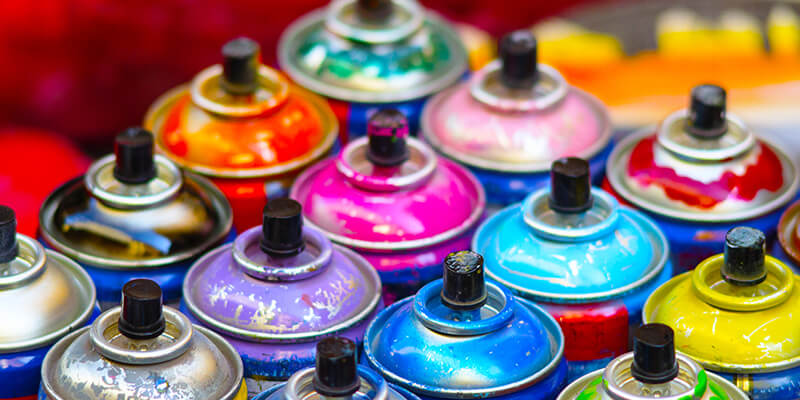Aerosol spray paint, also known as rattle cans, are produced in a sealed and pressurised container (can or tin). The paint is dispersed by depressing a nozzle on the top of the can, connected to a valve inside the can. Spray paint leaves a smooth, evenly coated surface, unlike many standard, rolled or brushed paint finishes. Generic aerosol cans are portable, light, affordable and easy to store.
Aerosol paint products have been used commercially and industrially by consumers for over 60 years; however, they have dramatically evolved over the years. Standard pressure cans are now used for faster and thicker coverage. Lower pressure cans, on the other hand, achieve more control and increased flexibility. With the technological improvements of spray cans, you can now purchase cans with a higher pressure system. This gives a much wider and more even finish, along with new distribution nozzles, giving you a much more professional finish on your project, even if you are a novice.
Basic use of an Aerosol Paint Can
- Shake the can well before use to mix the components inside. (Inside the can is a small ball which when shook, assists in mixing up the internal components, which gives the can the title “rattle can”)
- Ensure the area you are painting in is covered well, and ideally, you can open the area up after painting to clear out any fumes and paint in the air.
- Always wear a mask (ideally a double-filtered mask).
- Ensure you’re ready to paint the next stage without interruption (i.e. if you have already primed your project, ensure nothing else needs to be sanded or re-primed before you can move onto the base coat of colour. Alternatively, if you have applied the base coat, all runs have been flatted back and re-painted before you add the clear topcoat).
- Using a steady flow, move your arm from left to right over your substrate. This is called making a pass. You must depress the nozzle before you hit the substrate and release after you have left the substrate, making even passes as you go.
- If you have applied too much paint and you cause a run (a drop of paint running down the substrate) do not attempt to wipe or fix it when it’s wet. Let the paint dry properly and then sand the imperfection back and then remove any dust or grease and reapply a layer of paint.
- ALWAYS ensure you turn the can upside down and spray away from the project until the gas is clear coming from the can. This will dispel any remaining paint in the valve/nozzle so paint won’t dry in the line causing a blockage.

Storage of Aerosol Paint Cans
- Aerosol paint cans must be stored in a cool, dry place away from any naked flames.
- You must avoid moist conditions like garages, external sheds, laundries, bathrooms and etc. as this can rust the can and cause the can to fail or rupture.
- Aerosols must be kept away from any corrosive chemicals (pool chemicals, drain cleaners, bleach, toilet and bathroom cleaners, all types of kitchen and laundry detergents and alkali materials, etc.)
- NEVER store aerosol paint cans in heated areas or where any metal work (fabrication, welding or next to a radiator etc.) is being carried out. Heat can make create a reaction, and the cans can potentially combust.
- NEVER store aerosol paint cans in direct sunlight, heat can make the chemicals react and potentially combust.
- Aerosol paint cans must not be pierced or burnt, even when empty. There is a strong chance there could be some leftover chemical remnants or the pressured gas in the can, which can cause an explosion.
- Do not place an aerosol paint can in hot water to increase the internal pressure in order to enhance the spray.
- Do not smoke when using an aerosol paint can or immediately afterwards, due to the chemical or the gas I the can. This can again cause the flammable product to explode.





